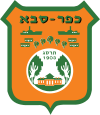Kfar Saba
Kfar Sava
|
|||
|---|---|---|---|
| Hebrew transcription(s) | |||
| • ISO 259 | Kfar Sava | ||
| • Translit. | Kfar Sava | ||
|
|||
| Coordinates: 32°10′17″N 34°54′30″E / 32.17139°N 34.90833°ECoordinates: 32°10′17″N 34°54′30″E / 32.17139°N 34.90833°E | |||
| Country |
|
||
| District | Central | ||
| Founded | 1903 | ||
| Government | |||
| • Type | City (from 1962) | ||
| • Mayor | Yehuda Ben-Hamo | ||
| Area | |||
| • Total | 14,169 dunams (14.169 km2 or 5.471 sq mi) | ||
| Population (2015) | |||
| • Total | 96,922 | ||
| Website | www.kfar-saba.muni.il (Hebrew) | ||
Kfar Saba (Hebrew: כְּפַר סָבָא), officially Kefar Sava, is a city in the Sharon region, of the Central District of Israel. In 2015 it had a population of 96,922.
The origins of the name are not known - in Hebrew it means 'grandfather's village'.
Kfar Saba (ancient Capharsaba) was an important settlement during the Second Temple period, and is mentioned for the first time in the writings of Josephus, in his account of the attempt of Alexander Jannaeus to halt an invasion from the North led by Antiochus (Antiquities, book 13, chapter 15). Kfar Saba also appears in the Talmud in connection to corn tithing and the Capharsaba sycamore fig tree.
Excavations on the site have revealed the remains of a large Roman bathhouse. In the Byzantine periods the ruins of the bathhouse were first converted into fish pools, and later into some form of industrial installation.
In 1596, the Arab village of Kafr Saba was inhabited by 42 Muslim families. In the 1870s it was described as "a mud village of moderate size with mud-ponds around it and good water in the wells of Neby Yemin, to the east." The Jewish town of Kfar Saba was established in 1898 on 7,500 dunams of land purchased from the Arab village. Despite attractive advertisements in Jerusalem and London, attempts to sell plots to private individuals were unsuccessful, as the land was located in a desolate, neglected area far from any other Jewish settlement. The Ottoman pasha of Nablus, to whose governorate the land belonged, refused to give building permits, therefore the first settlers lived in huts made of clay and straw. They earned their living by growing almonds, grapes and olives. Most of the manual laborers on the land were peasants from Qalqilya. Only in 1912 were permits given and the settlers moved to permanent housing.
...
Wikipedia



